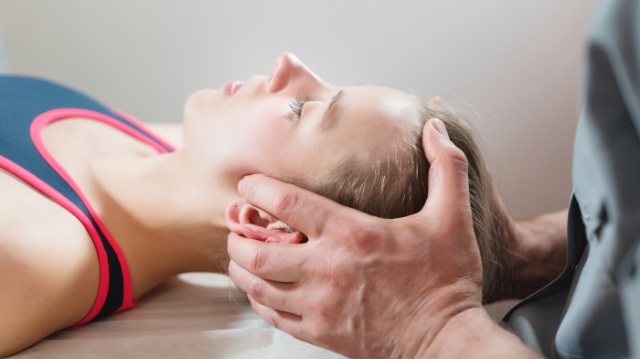News
Physical Therapy Is Usually The Best Choice for Jaw Pain

There are 22 bones in the face and head, but the lower jawbone—or mandible—is the only one of these that can move. The mandible connects to the temporal bone of the skull at two points just in front of each ear through the temporomandibular joint (TMJ). And as we discussed in our last post, the TMJ is of interest not only because it allows us to move our jaw in multiple directions so we can talk, yawn, and chew, but also because it’s a common location of pain.
If a temporomandibular disorder (TMD) does occur, you may scramble to figure out what to do next. Numerous interventions are available for TMDs, but there is a general principle we strongly recommend when deciding how to proceed: less is often best. This means you should avoid expensive and irreversible interventions that are not often necessary and instead choosing minimally invasive, safe, low–risk treatment options that have been proven to work.
Physical therapy is a conservative (non–surgical) treatment option for TMDs that specifically fits these criteria. When treating patients with TMDs, physical therapists employ a variety of movement–based strategies designed to reduce pain levels, restore normal jaw movement, and lessen stress on the jaw. The techniques utilized are gentle and involve a combination of patients’ own movements and the therapist moving specific structures in a particular manner to increase range of motion.
Each physical therapy treatment program for TMDs varies depending on the severity of symptoms and the findings of the initial evaluation, but some of the most frequently used interventions include the following:
- Posture education: there are several postures that can contribute to or worsen a TMD, such as sitting with your head positioned too far forward, which stresses the muscles of the TMJ; therefore, if posture is identified as a possible cause, your therapist will teach you to become more aware of your posture and try changing the position of your jaw, head, neck, breastbone, and shoulder blades when you're sitting and walking
- Manual therapy: another common intervention is manual therapy, in which various hands–on techniques are applied to increase movement and relieve pain in tissues and joints; your therapist may use manual therapy such as massage or soft–tissue mobilization to stretch the jaw to restore normal flexibility or break up scar tissues that may have developed
- Stretching and strengthening exercises: your therapist will also teach you to perform a specific set of exercises that won’t exert a lot of pressure on your TMJ, but can strengthen the muscles of the jaw and restore a more natural, pain–free motion
- Pain–relieving modalities: for severe pain, your physical therapist may administer additional interventions to alleviate it, such as electrical stimulation or ultrasound
Research supports the role of physical therapy for treating TMDs
Physical therapy is also supported by numerous studies that have found it to be an effective treatment for TMDs. In one study published in 2021, 322 patients with TMD symptoms underwent a physical therapy program that included patient education, stretching exercises for the neck muscles, strengthening exercises for the jaw muscles, relaxation techniques, and manual therapy. Patients participated in three 60–minute sessions per week for three weeks and were also instructed to perform daily home exercises. After completing treatment, patients experienced significantly less pain and significantly better coordination of jaw movements.
Another study called a systematic review and meta–analysis—which collects and analyzes research on the same topic—had similar results. Six high–quality studies called randomized–controlled trials were included in this analysis, all of which compared exercise to other treatments or placebo for patients with TMDs. Results showed that patients who underwent exercise therapy experienced moderate short–term benefits of reduced pain and improved flexibility compared to other treatments, and a mixed approach to exercise therapy was likely associated with the best outcomes.
If your therapist suspects that your TMD is caused by teeth alignment problems, jaw clenching, or teeth grinding, he or she may refer you to a dentist who specializes in TMDs for additional care. Dentists can correct these issues with devices like bite guards, which create a natural resting position that will relax the TMJ, relieve pain, and improve jaw function.
In our next post, we’ll explore why physical therapy is effective is also recommended for vertigo symptoms that may or may not be related to TMDs.
